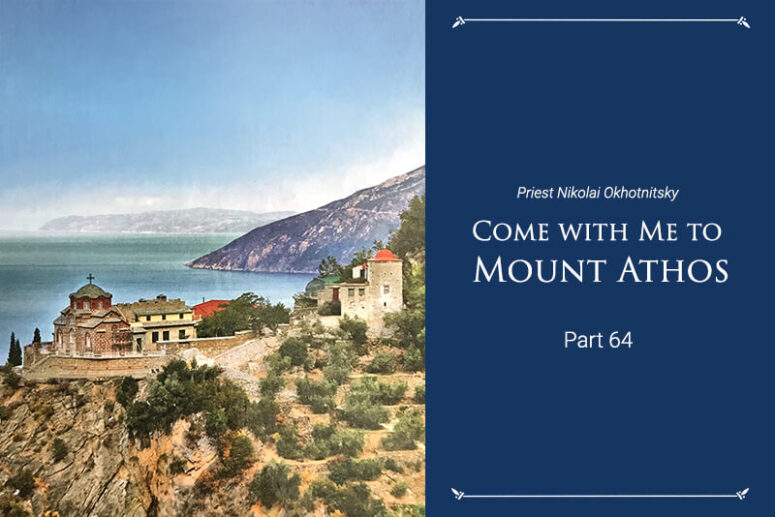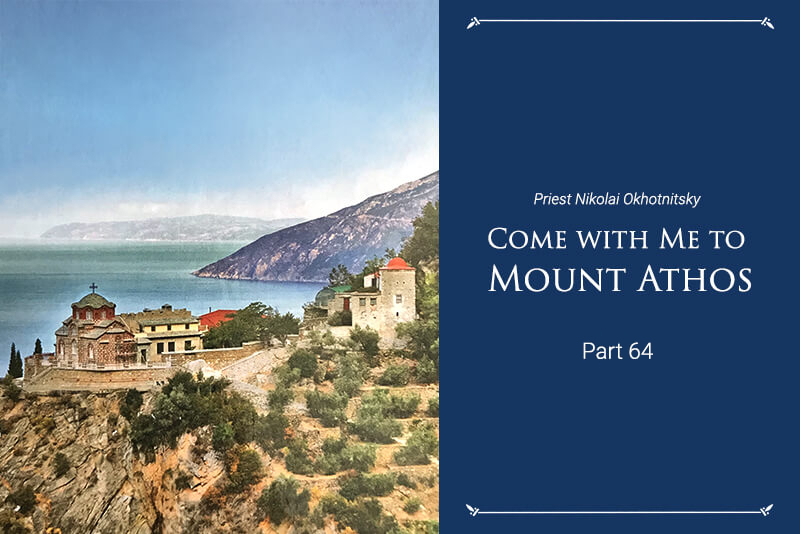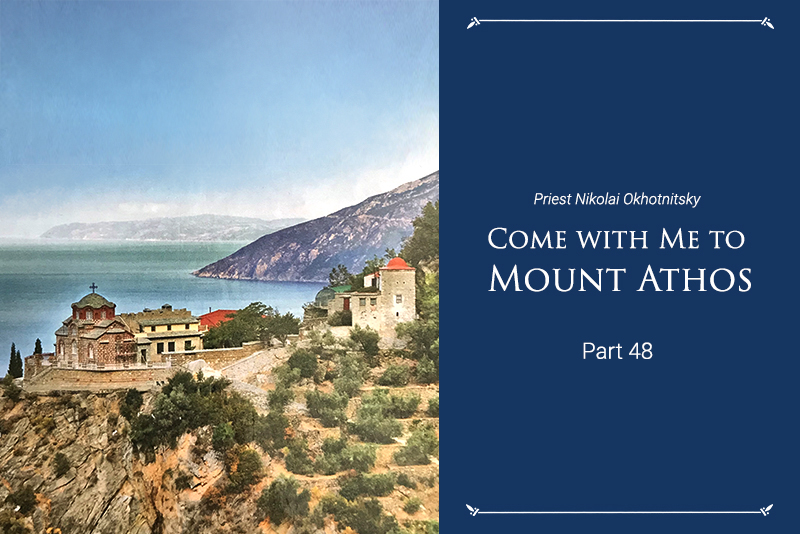
Docheiariou
In the meantime, we were already approaching the gates of the Docheiariou monastery. We were planning to conclude our visit to the Holy Mountain by venerating the miraculous icon of the Theotokos “Quick to Hear”. Again, we ran into the cheerful and energetic guys from Mouzenidis, the tourist company that welcomed us in Greece upon our arrival. They greeted us like old friends. It felt like we had never parted. Someone from their group went to get the hieromonk in charge of receiving pilgrims. Work was in full swing in the Monastery. For some time we were enjoying the sounds of hammers on the scaffolding, since no one was paying any attention to us. I walked along the shady alley parallel to the monastery walls. A ripe pomegranate fell from somewhere next to my feet. “Thank you! May I also take this lime as a keepsake?” I asked the guarding angel of the monastery and, without waiting for an answer, plucked a green fruit from a tree standing right there and put it into my pocket —
“Father Nikolai!” — the guys were calling me already.
“I’m coming!”
I hurried to follow everyone to the gift shop. Such was the order — first the gift shop, and then the icon. We usually found out in the monasteries that we visited which icons were miraculous and bought reproductions of these images in order to consecrate them at the actual shrines. We placed these images in a hard folder, intending to frame them after returning home. In Docheiariou, I was lucky to purchase a large size “Quick to Hear” image printed on fabric. An old hieromonk carefully folded the icon and inserted it into a cardboard tube, protecting the image from damage. The guys continued to browse through something else, while Father Sergius and I went towards the entrance to the catholicon. For some reason, we thought that the miraculous image should have been located there. The church turned out to be closed, and we sat down on wooden benches near the translucent glass doors, behind which I was guessing a sunlit passage and something resembling a large icon.
“Maybe this is the “Quick to Harken”?”
Showing his childlike simplicity once more, Father Sergius pulled the copper handle, opening the glass door. We went inside. The most pure face of the Mother of God was looking at us. There were so many offerings that the icon was almost completely hidden behind them. Bishop’s panagias and award crosses hung there among different watches, bracelets, gold rings and silver plates with images. Following a wonderful Greek tradition, pilgrims bring these plates as gifts to the holy icon in gratitude for having their prayers answered. The images on these plates showed what the unknown petitioners had been asking for. Realizing that all of them were men (because women do not come here) and seeing multitudes of children’s figures and women’s faces on the plates makes you understand that a man’s heart is not alien to love and sentimentality. We prayed on our knees until other pilgrims began to crowd behind us.
The same hieromonk who had previously welcomed us came to speak about the icon. Our friends were translating his words for us, so we had no difficulties with the language.
The prototype of the icon, according to monastic tradition, was painted during the lifetime of St. Neophytos, founder of the monastery who lived in the 10th – 11th century. By 1664, the icon was placed in a niche, on the outer side of the wall, in front of the entrance to the monastery refectory.
Once, a manciple named Nilos was passing there with a lit torch holding it so close to the Icon that the soot from the torch lay on the holy face. He heard a voice coming from the icon, “In the future, do not come here with a lighted torch and do not blacken my Image with soot.” At first, Nilos was afraid, but then, telling himself that one of the brothers must have spoken to him, he calmed down and continued to walk past the icon with a lit candle, inadvertently darkening the image with smoke. It was not long before he heard the voice again saying, “O monk, unworthy of the name, how long will you continue to darken my Icon with smoke?” Upon hearing these words, the manciple was struck blind. Only then did he realize whose words those were, and how he deserved his punishment. The next morning, the brethren found him lying on the floor of the corridor before the Icon. When they learned about what had happened, they placed a sanctuary lamp before the image of the Theotokos, and had it censed every night, while praying diligently that their brother might receive back his sight. Nilos remained before the Icon, calling upon the Theotokos with tears and lamentations to forgive him for the sin he had committed. One day, his prayer was answered. He was praying and weeping before the holy icon, when he heard a voice, saying, “Nilos! Your prayer has been heard. I forgive you and shall give back sight to your eyes. When you have received this mercy from me, announce to the brothers that I am their Protectress, the Guardian and Defender of this Monastery dedicated to the Archangels. Let them and all Orthodox Christians come to Me in necessities, and I will forsake not one of them. For to all who have recourse to me in veneration, I will be their Advocate, and my Son and God will fulfil all their petitions, for the sake of my mediation before Him. For this reason, My icon shall be called “She Who Is Quick To Hear” for I shall speedily show mercy and fulfil the petitions of all who hasten to it.”
Nilos received back his sight. Reports of this miracle swiftly spread throughout the Holy Mountain attracting many monks, desiring to be eyewitnesses of this miraculous event.
A special and incessant veneration of the glorified icon was established in Docheiariou. The brethren closed the passage to the refectory, over which the icon was located, forming a semblance of a chapel. A church was then built to the right of the icon in the name of the Most Holy Theotokos “She Who Is Quick to Hear”. A monk is chosen regularly among the brethren whose duties include taking care of the vigil lamps, reading prayers in front of the icon in the morning and evening, and cleaning the chapel and the church in honor of the miraculous icon. On Tuesdays and Thursdays, the brethren celebrate a special prayer service to the icon in the monastery cathedral.
Since then, many miracles have been performed in connection with this holy icon: the blind have received their sight, the lame have walked, and men have been rescued from imprisonment and shipwreck. In Russia, copies of the “Quick to Hear” icon have always enjoyed great love and reverence, with many of them becoming famous for miracles, especially healing from epilepsy and demonic possession.
Later we also learned the continuation of this wonderful story.
Translated by The Catalogue of Good Deeds
All chapters are here




